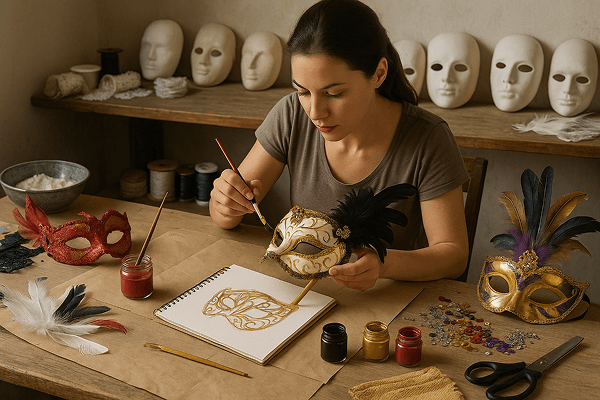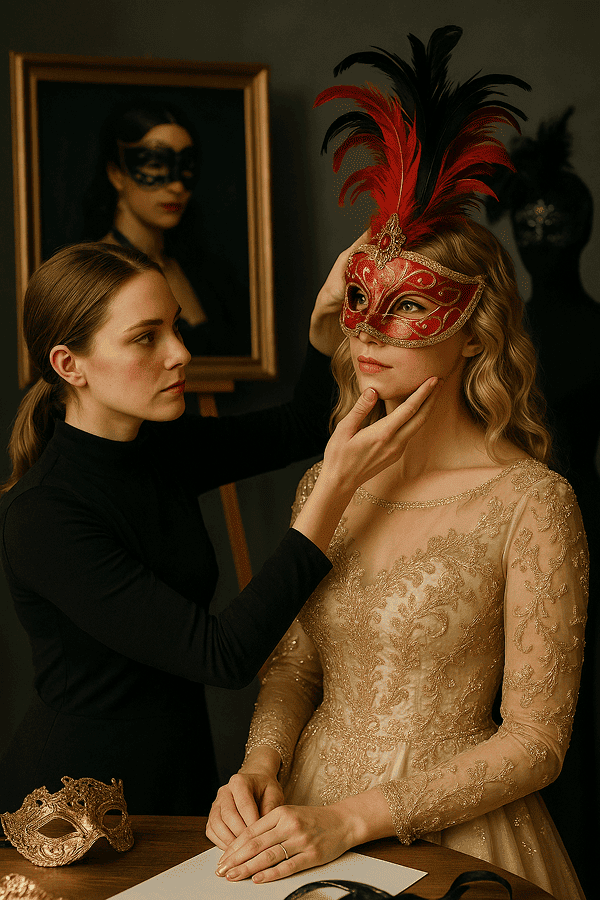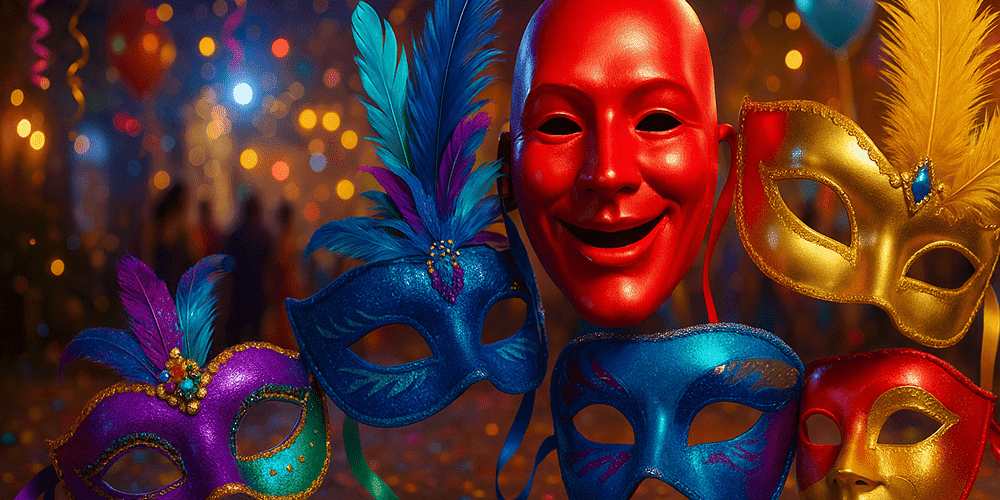Party Masks, also known as masquerade party masks, are festive accessories designed to conceal the wearer’s identity and add an element of mystery and excitement to social gatherings. Instantly recognizable for their playful, colorful, and often glamorous designs, Party Masks are adorned with feathers, glitter, sequins, beads, and intricate patterns. Ranging from simple half-masks to elaborate full-face creations, they remain a staple at masquerade balls, themed parties, carnivals, and modern celebrations around the world. While rooted in European masquerade traditions, today’s Party Masks are a global phenomenon, bridging cultural divides and evolving with contemporary trends. For those interested in the broader tradition, Ball Masks represent a closely related form often featured at grand events.
Historical Origins of Party Masks
The origins of Party Masks stretch back to medieval and Renaissance Europe, particularly Italy and France. The term “masquerade” is derived from the Italian “maschera,” meaning mask. Early masquerade balls in Venice, known as “mascherata,” became a cornerstone of Carnival, where masks allowed participants to transcend social boundaries and explore forbidden pleasures.
During the Baroque and Rococo periods, masquerade balls spread to France, England, and Austria, with masks serving both as fashion statements and tools for anonymity. Their designs evolved from simple leather visors to ornate masks adorned with gold leaf, lace, and jewels. The tradition later merged with theatrical customs, such as commedia dell’arte, and public festivities, becoming a symbol of both celebration and social inversion.
Significant artifacts, including antique Venetian masks and 18th-century French party masks, are preserved in museums and private collections. The popularity of party masks expanded further with the spread of Carnival to the Americas and beyond, where local cultures infused their own motifs and materials.
Cultural Significance and Symbolism of Party Masks
Party Masks hold deep symbolic meaning. In their original context, they represented freedom, secrecy, and the temporary suspension of social hierarchies. Masked parties allowed individuals to express hidden aspects of their personality, engage in playful flirtation, or satirize authority without fear of reprisal.
Religiously and spiritually, masks have been linked to rites of passage, seasonal festivals, and the invocation of spirits in many cultures. Myths and legends often surround iconic masks, with stories of intrigue, romance, and transformation tied to masquerade traditions.
Socially, Party Masks foster a sense of unity and equality, as wearers mingle freely and explore new roles. In many cultures, the act of donning a mask is seen as both a liberation and a challenge, encouraging creativity, spontaneity, and communal bonding.
Materials and Crafting Techniques of Party Masks
Traditional Party Masks are made from materials such as papier-mâché, leather, fabric, ceramics, and lightweight metals. Modern versions often use plastic, foam, or synthetic fibers for comfort and affordability. The crafting process typically includes:
- Designing and sketching the mask’s shape
- Sculpting a mold or base (often from clay or plaster)
- Layering materials (papier-mâché, leather, or fabric) and allowing them to set
- Painting, decorating, and attaching embellishments such as sequins, rhinestones, feathers, or lace
- Adding straps, ribbons, or handles for wearing

Special techniques include gilding, embossing, airbrushing, and laser-cutting for intricate designs. Regional differences abound: Venetian masks are famous for their metallic leaf and hand-painted details, while Latin American masks might feature vivid colors and folk art motifs. Color symbolism is important — gold for elegance, red for passion, black for mystery, and blue for calm or fantasy.
On toddmasks.com, you’ll find tutorials and artisan interviews exploring the artistry behind party mask creation.
Functions and Uses of Party Masks
Party Masks are worn for a variety of purposes:
- Ritual and Ceremonial Use: Historically, masks played a role in rites of passage, seasonal celebrations, and religious festivals.
- Theatrical Application: Many party masks draw inspiration from theatrical traditions, allowing performers to embody comedic or dramatic characters.
- Festivals and Holidays: Masks are central to carnivals, masquerade balls, Mardi Gras, Halloween, and themed parties.
- Modern Events: Today, Party Masks appear at proms, weddings, New Year’s Eve galas, and fashion shows, as well as virtual parties and photo shoots.
- Decorative and Artistic Use: Some masks are created as collectible art pieces or interior decor.
Over time, the function of party masks has shifted from ritual and theatrical to primarily social and decorative, yet their transformative power remains.
Regional Variations of Party Masks
Party Masks exhibit remarkable regional diversity:
- Venetian Party Masks: Renowned for their elegance, gold leaf, and Baroque ornamentation.
- Latin American Masks: Feature bold colors, animal motifs, and folk art influences, especially during Carnival.
- Asian Party Masks: May draw on opera traditions, with stylized designs from Japan, China, and Korea.
- African and Middle Eastern Masks: Sometimes adapted for themed parties, incorporating tribal or geometric patterns.
- Contemporary Western Masks: Often experiment with minimalism, fantasy, or avant-garde forms.
Comparing Party Masks to other masquerade traditions, such as Ball Masks or Carnival Masks, reveals both shared roots and unique cultural expressions.
Famous Examples and Notable Collections of Party Masks
Notable Party Masks are preserved in major museums, including the Victoria and Albert Museum (London), Musée Carnavalet (Paris), and Museo di Palazzo Mocenigo (Venice). Iconic examples include antique Venetian masks, Art Deco party masks, and contemporary artist-designed pieces.
Private collectors and fashion houses often commission limited-edition masks for special events. Historic finds — such as 18th-century English masquerade masks or hand-painted French visors — enrich our understanding of the evolution of party mask culture. Digital galleries and expert commentary are available on toddmasks.com.
Influence of Party Masks on Art and Culture
Party Masks have shaped visual arts, theater, literature, and fashion. Their dramatic forms inspire painters, sculptors, and costume designers. In literature and cinema, masks symbolize mystery, transformation, and hidden identity. In music and performance art, masked personas allow for creative reinvention and spectacle.

Fashion designers frequently reference masquerade motifs in haute couture, accessories, and runway shows. The preservation and celebration of party mask traditions play a vital role in cultural heritage and contemporary innovation.
Contemporary Status and Preservation of the Party Mask Tradition
Today, Party Masks are more popular and diverse than ever. Master artisans and emerging designers experiment with new materials, digital fabrication, and interactive elements. Workshops, cultural organizations, and online platforms like toddmasks.com offer mask-making classes and educational resources.
Innovations include eco-friendly materials, LED lighting, augmented reality masks for digital events, and collaborations with artists in other media. Annual masquerade balls, carnivals, and themed parties ensure the tradition remains relevant and exciting.
Collecting and Acquiring Party Masks
The market for Party Masks ranges from affordable mass-produced items to high-end, artist-signed collectibles. Authentic masks can be found in artisan studios, galleries, museum shops, and reputable online platforms such as toddmasks.com. Prices vary by material, craftsmanship, age, and provenance.
Tips for collectors:
- Seek masks with quality materials and clear provenance
- Support living artisans and fair-trade practices
- Avoid mass-produced or counterfeit items
- Consider documentation and ethical aspects of collecting
Toddmasks.com provides guidance on authenticity, valuation, and responsible collecting.
